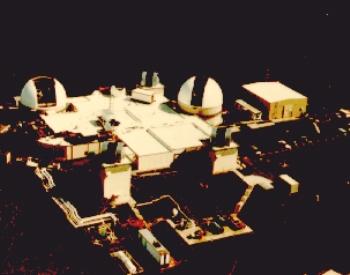
The Ground-Based Electro-Optical Deep Space Surveillance (GEODSS), which
can track objects as small as a basketball more than 20,000 miles in space,
play a vital role in tracking space objects, particularly those in deep
space. Over 1,200 objects, including geostationary communications satellites,
are in deep space more than 3,000 miles from earth.
-
- There are three operational GEODSS sites
that report to the 21st Space Wing, headquartered at Peterson Air Force
Base, Colo. Sites are located at Socorro, N.M.; Maui, Hawaii; and Diego
Garcia, British Indian Ocean Territories.
-
- The GEODSS system is the successor to
the Baker-Nunn camera, which was developed in the mid-1950's to provide
surveillance data. The GEODSS concept was developed and researched by Massachusetts
Institute of Technology Lincoln Laboratories at an experimental test site
located at Socorro, N.M. the site is still used by MIT.
-
- To perform its mission, GEODSS brings
together the telescope, low-light-level television and computers -- three
proven technologies. Each site has three telescopes, two main and one auxiliary,
with the exception of Diego Garcia, which has three main telescopes. The
main telescopes have a 40-inch aperture and a two-degree field of view.
The system only operates at night when the telescopes are able to detect
objects 10,000 times dimmer than the human eye can detect. Since it is
an optical system, cloud cover and local weather conditions influence its
effectiveness.
-
- The telescopes move across the sky at
the same rate as the stars appear to move. This keeps the distant stars
in the same positions in the field of view. As the telescopes slowly move,
the GEODSS cameras take very rapid electronic snapshots of the field of
view. Four computers then take these snapshots and overlay them on each
other. Star images, which remain fixed, are electronically erased. Man-made
space objects, however, do not remain fixed and their movements show up
as tiny streaks which can be viewed on a console screen. Computers measure
these streaks and use the data to figure the positions of objects such
as satellites in orbits from 3,000 to 22,000 miles. This information is
used to update the list of orbiting objects and sent nearly instantaneously
from the sites to Cheyenne Mountain Air Force Base.
-
- RESOURCES
-
- * Ground Based-Electro-Optical Deep Space
Surveillance (GEODSS) * GEODSS TN Homepage
-
- http://www.fas.org/spp/military/program/track/geodss.htm
Implemented by Charles P. Vick, Sara D. Berman, and Christina Lindborg,
1997 Scoville Fellow Maintained by John Pike
|